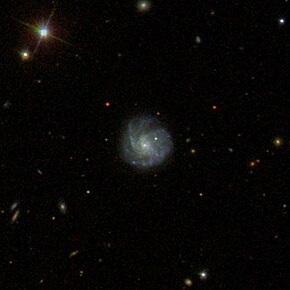| NGC 3678 | |
|---|---|
 A Sloan Digital Sky Survey (SDSS) image of NGC 3678 | |
| Observation data (J2000 epoch) | |
| Constellation | Leo |
| Right ascension | 11h 26m 15.70s[1] |
| Declination | +27° 52′ 01.00″[1] |
| Redshift | 0.02404±0.00001[1] |
| Distance | 361 Mly (110.75 Mpc)[1] |
| Apparent magnitude (V) | 13.5[1] |
| Characteristics | |
| Type | Sbc[1] |
| Size | 127,000 ly |
| Apparent size (V) | 0.724′ × 0.692′[1] |
| Notable features | N/A |
| Other designations | |
| PGC 35177,[1] UGC 6443,[1] Z 156-75,[1] LEDA 35177,[1] MCG +05-27-071[1] | |
NGC 3678 is a spiral galaxy located around 361 million light-years away in the constellation Leo.[1][2] NGC 3678 was discovered on April 13th, 1831 by the astronomer John Herschel, and its diameter is 127,000 light-years across.[1] NGC 3678 is not known to have much star-formation, and it is not known to have an active galactic nucleus.[3][4]
- ^ a b c d e f g h i j k l m n "By Name | NASA/IPAC Extragalactic Database". ned.ipac.caltech.edu. Retrieved 2024-04-01.
- ^ "NGC 3678 - Spiral Galaxy in Leo | TheSkyLive.com". theskylive.com. Retrieved 2024-04-01.
- ^ "New General Catalog Objects: NGC 3650 - 3699". cseligman.com. Retrieved 2024-04-01.
- ^ "NGC 3678 - Galaxy - SKY-MAP". www.wikisky.org. Retrieved 2024-04-01.